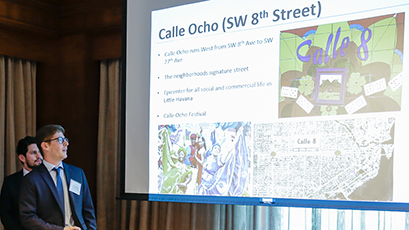Bender teamed up with graduate business students Ariel Fraynd and Stephen Englert to present "Havana NEXT," a small-scale apartment development project adjacent to a new Cuban Cultural Center in Miami’s Little Havana neighborhood. “We wanted to offer a model for the redevelopment of the area’s small residential lots, while staying faithful to the community’s Hispanic heritage.”
Guided by the School’s Real Estate Advisory Board, Andrea Heuson, professor of finance, organized the semester-long graduate student competition, which offered $25,000 in prizes and drew entries from the Northeast as well as Florida. “We hosted the event to educate students about the many types of impactful investing that are available in any community,” she said. “Real estate investment is often perceived as being immune to social issues but that is just not true, as demonstrated by the many different projects in the competition."
Heuson added that impact investing refers to commercial real estate projects that are designed to generate a beneficial social or environmental impact along with an appropriate financial return. The four finalist teams identified vacant or underutilized commercial properties and proposed uses for the site that included at least one of those impact components.
The Rutgers University team took first place and an $11,000 prize, while the Cornell University team was second with a $9,000 prize, the University of Miami team was third with a $3,500 prize, and the Florida International University team was the fourth-place finalist, earning $1,500.
"We felt all the student teams made very good presentations," said Jaret Turkell, managing director, HFF, who was one of the competition judges. Others included Arnaud Karsenti, 13th Floor Investments in Miami, and Kasia Pozniak, Prudential Global in New York, whose company prepared a tutorial on impact investing that was sent to the competing teams ahead of time. "The students delivered their views clearly and concisely and they all have great futures ahead of them."
The Rutgers team’s project was "Pointe Grande Plaza," a retail mall in Elizabeth, New Jersey, anchored by a Supermarket Plus IGA, that addressed a “food desert,” mitigated environmental contamination on the site, and created 90 new jobs in the surrounding low-income community. The $17.4 million public-private projects required a complex capital stack that included federal, state, and local incentives to attract a private developer. “With its positive environmental and social benefits, this project exemplifies impact investing,” said Pozniak after the presentation.
The Cornell University team presented “The Linc,” a large-scale project to transform a 6.5-acre former industrial site along the North Branch Chicago River into a $1.7 million mixed-use development with 594 residential units. The $486 million projects would include a tech hub and affordable housing while contributing to the neighborhood’s urban rejuvenation.
A proposed mixed-use redevelopment of South Miami's City Hall property called "SoMiPark" was presented by the FIU team. This $81 million project would include transit-oriented housing, retail shops, a cultural center and a community garden connecting with the Underline Linear Park under the Metrorail line west of U.S. 1.
The three UM students proposed a $1.9 million eight-unit rental building on a Little Havana site with a new Cuban Cultural Center, funding through private donations, on the adjacent lot. “We hope this pioneering project would spur community reinvestment,” said Fraynd.
Looking ahead, Heuson said, “We plan to make the competition an annual event and eventually to expand to an undergrad division. Next year we will be back with more schools and more interesting, impactful projects.”

